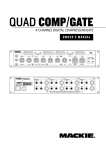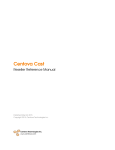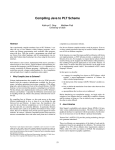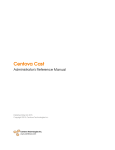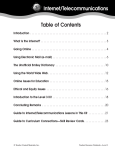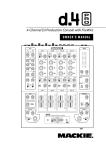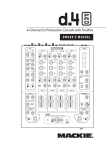Download Mackie Stereo and Mono Side chain Compressor User`s guide
Transcript
USER’S GUIDE Stereo and Mono Sidechain Compressor plug-ins For Tracktion 2 Stereo and Mono Sidechain Compressors for Tracktion Mackie Software License Please read this license carefully before using the accompanying Software. By downloading and using the Software, you are agreeing to be bound by the terms of this license. Software as used herein means all computer code (both source and object) including, but not limited to, all interfaces, navigational devices, search engines, databases, menus, menu structures or arrangements, drivers, development tools, icons, operational instructions, scripts, commands, and syntax, whether created, or licensed from third parties by LOUD Technologies Inc., including all associated documentation. 1. Software License. Any Software whether on disk, in read-only memory, or on any other media, and related documents are licensed to you by LOUD Technologies Inc. You own the disk(s) on which the Software is recorded but LOUD Technologies and/or LOUD Technologies’ Licensor(s) retain all rights, title, and interest to the Software and related documentation. This License allows you to use the Software on a single computer and make one copy of the Software in machine-readable form for backup purposes only. You must reproduce on such copy LOUD Technologies’ copyright notice and any other proprietary legend on the original copy of the Software. 2. Restrictions on Software Use. The Software contains copyrighted material, trade secrets and other proprietary material and in order to protect them you may not decompile, reverse engineer, disassemble or otherwise reduce the Software to human-perceivable form, or in any way analyze or utilize in a manner inconsistent with this license, or allow a third party to do so. You may not modify, network, rent, lease, loan, distribute, create derivative works, or use the Software to create a compilation based upon the Software in whole or in part. You may not electronically transmit the Software from one computer to another over a network or other means of transmission. 3. Support. You acknowledge and agree that LOUD Technologies may not offer any technical support in the use of the Software. 4. Termination. This License is effective until terminated. You may terminate this License at any time by destroying the Software and related documentation and all copies thereof. This License will terminate immediately without notice from LOUD Technologies if you fail to comply with any provi- 2 User’s Guide sions of this License. Upon termination you must destroy the Software and related documentation and all copies thereof. 5. Export Law Assurances. You agree and certify that neither the Software nor any other technical data received from LOUD Technologies, nor the direct product thereof, will be exported outside the United States except as authorized and as permitted by the laws and regulations of the United States and with LOUD Technologies’ express permission. 6. Government End Users. If you are acquiring the Software on behalf of any unit or agency of the United States Government, the following provisions apply. The Government agrees: (i) if the Software is supplied to the Department of Defense (DOD), the Software is classified as “Commercial Computer Software” and the Government is acquiring only “restricted rights” in the Software and its documentation as that term is defined in Clause 252.227-701(c)(1) of the DFARS; and (ii) if the Software is supplied to any unit or agency of the United States Government other than DOD, the Government’s rights in the Software and its documentation will be defined in Clause 52.227-19(c)(2) of the FAR or, in the case of NASA, in clause 18-52.227-86(d) of the NASA supplement to the FAR. 7. Limited Warranty on Software Media (if provided on disks). LOUD Technologies Inc. warrants the disks on which the Software is recorded to be free from defects in materials and workmanship under normal use for a period of ninety (90) days from the date of purchase as evidenced by a copy of the purchase receipt. LOUD Technologies’ entire liability and your exclusive remedy will be the replacement of the defective disk when it is returned postage prepaid to LOUD Technologies at the address below or a Mackie authorized representative with a copy of the purchase receipt. LOUD Technologies will have no responsibility to replace a disk damaged by accident, abuse or misapplication. THIS WARRANTY SPECIFICALLY EXCLUDES ANY OTHER WARRANTY RELATED TO SOFTWARE MEDIA, INCLUDING, BUT NOT LIMITED TO, ANY IMPLIED WARRANTIES ON THE DISKS, SUCH AS THE IMPLIED WARRANTIES OF MERCHANTABILITY OR FITNESS FOR A PARTICULAR PURPOSE OR USE. THIS WARRANTY GIVES Stereo and Mono Sidechain Compressors for Tracktion YOU SPECIFIC LEGAL RIGHTS, AND YOU MAY ALSO HAVE OTHER RIGHTS, WHICH VARY FROM STATE TO STATE AND FROM COUNTRY TO COUNTRY. 8. Disclaimer of Warranty on Software. You expressly acknowledge and agree that use of the Software is at your sole risk. The Software and related documentation are provided “AS IS” and without warranty of any kind. LOUD TECHNOLOGIES EXPRESSLY DISCLAIMS ALL WARRANTIES, EXPRESS OR IMPLIED, INCLUDING, BUT NOT LIMITED TO, THE IMPLIED WARRANTIES OF MERCHANTABILITY AND FITNESS FOR A PARTICULAR PURPOSE OR USE. LOUD TECHNOLOGIES DOES NOT WARRANT THAT THE FUNCTIONS CONTAINED IN THE SOFTWARE WILL MEET YOUR REQUIREMENTS, OR THAT THE OPERATION OF THE SOFTWARE WILL BE UNINTERRUPTED OR ERROR-FREE, OR THAT DEFECTS IN THE SOFTWARE WILL BE CORRECTED. FURTHERMORE, LOUD TECHNOLOGIES DOES NOT WARRANT OR MAKE ANY REPRESENTATIONS REGARDING THE USE OR THE RESULTS OF THE USE OF THE SOFTWARE OR RELATED DOCUMENTATION IN TERMS OF THEIR CORRECTNESS, ACCURACY, RELIABILITY, OR OTHERWISE. NO ORAL OR WRITTEN INFORMATION OR ADVICE GIVEN BY LOUD TECHNOLOGIES OR A MACKIE AUTHORIZED REPRESENTATIVE SHALL CREATE A WARRANTY OR IN ANY WAY INCREASE THE SCOPE OF THIS WARRANTY. SHOULD THE SOFTWARE PROVE DEFECTIVE, YOU (AND NOT LOUD TECHNOLOGIES OR ANY MACKIE AUTHORIZED REPRESENTATIVE) ASSUME THE ENTIRE COST OF ALL NECESSARY SERVICING, REPAIR OR CORRECTION. SOME STATES DO NOT ALLOW THE EXCLUSION OF IMPLIED WARRANTIES, SO THE ABOVE EXCLUSION MAY NOT APPLY TO YOU. 9. Limitation of Liability. UNDER NO CIRCUMSTANCES INCLUDING NEGLIGENCE, SHALL LOUD TECHNOLOGIES BE LIABLE FOR ANY INCIDENTAL, SPECIAL OR CONSEQUENTIAL DAMAGES INCLUDING, BUT NOT LIMITED TO, LOST PROFITS OR EARNINGS, DAMAGE TO PROPERTY OR PERSON, OR ATTORNEYS’ FEES THAT RESULT FROM THE USE OR INABILITY TO USE THE SOFTWARE OR RELATED DOCUMENTATION, EVEN IF LOUD TECHNOLOGIES OR A MACKIE AUTHORIZED REPRESENTATIVE HAS BEEN ADVISED OF THE POSSIBILITY OF SUCH DAMAGES. SOME STATES DO NOT ALLOW THE LIMITATION OR EXCLUSION OF LIABILITY FOR INCIDENTAL OR CONSEQUENTIAL DAMAGES SO THE ABOVE LIMITATION OR EXCLUSION MAY NOT APPLY TO YOU. IN NO EVENT SHALL LOUD TECHNOLOGIES’ TOTAL LIABILITY TO YOU FOR ALL DAMAGES, LOSSES, AND CAUSES OF ACTION (WHETHER IN CONTACT, TORT (INCLUDING NEGLIGENCE) OR OTHERWISE) EXCEED THE AMOUNT PAID BY YOU FOR THE SOFTWARE. 10. Controlling Law and Severability. This License shall be governed by and construed in accordance with the laws of the United States and the State of Washington, as applied to agreements entered into and to be performed entirely within Washington between Washington residents. If for any reason a court of competent jurisdiction finds any provision of this License, or portion thereof, to be unenforceable, that provision of the License shall be enforced to the maximum extent permissible so as to effect the intent of the parties, and the remainder of the License shall continue in full force and effect. 11. Complete Agreement. This License constitutes the entire agreement between the parties with respect to the use of the Software and related documentation, and supersedes all prior or contemporaneous understandings or agreements, written or oral, regarding such subject matter. No amendment to or modification of this License will be binding unless in writing and signed by a duly authorized representative of LOUD Technologies Inc. LOUD Technologies Inc. • 16220 Wood-Red Road NE • Woodinville, WA 98072 • USA ©2005 LOUD Technologies Inc. User’s Guide 3 Stereo and Mono Sidechain Compressors for Tracktion Iconography This icon will lead you to some further explanations of features and practical tips. This icon marks information that is very important, so please make sure you have a read. This icon does not appear in this guide. Well except here of course. Note: Visit our website at www.mackie.com to obtain the latest manuals and downloads for all your Mackie products. “Mackie” and the “Running Man” figure are trademarks or registered trademarks of LOUD Technologies Inc. VST is a trademark of Steinberg Media Technologies GmbH. All other brand names mentioned are trademarks or registered trademarks of their respective holders, and are hereby acknowledged. Part No. SW0214 Rev. A 7/05 © 2005 LOUD Technologies Inc. All Rights Reserved. 4 User’s Guide Stereo and Mono Sidechain Compressors for Tracktion Contents Mackie Software License-------------------------2 Examples -------------------------------------------21 Introduction ----------------------------------------6 Main Features -------------------------------------- 6 A brief word about Compressors--------------- 7 Standard vs. Sidechain Compressors ---------- 7 Expansion--------------------------------------------21 Leveling ----------------------------------------------21 Limiting ----------------------------------------------21 Hard Knee and Soft Knee Compression ------ 22 Snare Track Compression------------------------ 22 Specifications--------------------------------------23 Adding the Sidechain Compressor in Tracktion --------------------------------------------8 Need Help?----------------------------------------- 23 Setting up a new Rack Filter--------------------- 8 Example 1: Compressor triggering from another track -------------------------------------- 9 Setting up the Key Input ------------------------- 9 Setting up the Main Input----------------------- 10 Adding an EQ to the Key Input------------------ 11 Example 2: Compressor triggering from the same track ------------------------------------ 12 Appendix: Using Compressors ---------------- 24 Dynamic Range------------------------------------24 What a Compressor does -----------------------24 Stereo or “Program” Compressors ------------ 25 Compressor Artifacts ---------------------------- 25 Breathing ------------------------------------------- 25 Pumping--------------------------------------------- 25 Setting up the Key Input to be the same as the main input, but with an EQ ----------------------12 Using the EQ to drop off the lows------------- 14 Working the Knobs -------------------------------26 Sidechain Compressor Features----------------15 The Bottom Line ----------------------------------26 Global Controls ----------------------------------- 16 User Presets -------------------------------------- 27 The Compressor as a Tone Modifier----------- 26 The Contour Edit Screen ------------------------ 17 Threshold--------------------------------------------17 End Point---------------------------------------------17 Compression Ratio-------------------------------- 18 Gain Makeup and Auto Makeup --------------- 18 Attack and Release ------------------------------- 18 Soft Clip On and Threshold--------------------- 19 Node Editing --------------------------------------- 19 Node Selector Knob ------------------------------ 19 Reduction Meter ----------------------------------20 Input and Output Meters -----------------------20 Input and Output OL LEDs ----------------------20 User’s Guide 5 Stereo and Mono Sidechain Compressors for Tracktion Introduction Thank you for choosing Mackie software products for your computer-based audio recording system. The Stereo and Mono Sidechain Compressor plug-ins come with Tracktion, our easy-to-use music production software application. When you install Tracktion, the plug-ins are automatically installed in Tracktion's plug-ins folder. Note: These plug-ins only work with Tracktion, and will not work with any other VST host applications you may have on your computer. Typically, these plug-ins are used as compressors, so that's why we call them that. However, depending on the settings of the graphical interface, they can act as compressors, limiters, expanders, or a combination of all three. The Sidechain allows the compressor to take its cue from a separate input, and apply its action to another. For example, a vocal track can drop the level of a music track (ducking), such as when an announcement is made over background music, or where your vocals are a bit lost in the mix. The Sidechain Compressor can also take its trigger input from a copy (or EQ'd copy) of itself. For example, it can be used as a basic De-Esser, to compress the higher "Sssss" sounds, or you can apply compression to a guitar's mid or higher frequency range, leaving the lower-frequency range uncompressed. The features of the Mono Sidechain Compressor and the Stereo version are identical, so this manual applies to both plug-ins. The Mono version works for one key input and the main input, and the Stereo version works its magic for the key input and the stereo inputs, stereo.wav, or after another stereo plug-in. 6 User’s Guide Main Features • • • • • • • • • • • • • • • • • • • • • • • Stereo and mono compressor plug-in for Tracktion Key Input Key Solo engage/disengage Full stereo (or mono) operation Rather fetching graphic display Node edit selector Global enable button Favorite settings can be saved as presets Memories A and B for quick comparisons Input, output, and gain reduction metering Release control Attack control Threshold control End point control Input level control Output level control Compression Ratio readout Soft clip threshold control and indicator Soft clip engage/disengage Gain makeup control Auto gain makeup engage/disengage Rugby ball inflator The imaginary audio friend you always wanted to come to life so everyone could see that you were just not imagining things Stereo and Mono Sidechain Compressors for Tracktion A brief word about Compressors As an example of how to use a compressor, supposing you have a track with a wide dynamic range. This may have some exquisitely detailed and quiet passages, played before breaking into the final crescendo of Heavy Metal finalcrecendo-ings. Loud A standard compressor detects the level of the input signals from the main (host) track, and applies the math to this track to produce the processed output signals. Wide Dynamic Range This track may overpower the othQuiet er tracks during the loud passages, and yet if we drop the track's overall level, the quiet passages may be lost in the mix. The compressor allows us to drop (compress) the level of the higher passages, once they get louder than a threshold level. When the music is quieter than the threshold, it is not affected. This decreases the dynamic range of the track, and allows it to be a better fit in the mix. Standard vs. Sidechain Compressors Loud Less Dynamic Range Quiet The overall level of the track can be adjusted using the makeup gain, or automatic makeup gain. This compensates for the reduced output once the compressor has been at work, and lets you place your track's level relative to the other tracks. The features and controls of this compressor plug-in are similar to what you might find on a real-life beer-stained electronic compressor. LEVEL DETECTOR AND CONTROLS INPUT OUTPUT A Sidechain compressor has an extra (Key) input compared to a standard compressor. The sidechain compressor can detect the level of input signals from the main track OR the signal level from an alternate source. The alternate source can be a processed version of the main track, or the output of a different track. KEY INPUT INPUT LEVEL DETECTOR AND CONTROLS OUTPUT The math or processing applied to the main track reflects the signal fed into the sidechain. In this way, we can have one track triggering the compression of another. If the key input signal goes above the threshold, the plug-in will compute the amount of compression and apply it to the main input (even if it has not gone over the threshold). If you add an EQ plug-in to the Key Input line, you can narrow in on a desired frequency range for your compressor to work from. To make the connections in Tracktion, you must use the Rack Filters option, and assign which track will be connected to the Key Input. An example of this is shown on the next page, so fear not. User’s Guide 7 Stereo and Mono Sidechain Compressors for Tracktion Adding the Sidechain Compressor in Tracktion The first thing to do is to open up Tracktion and open your project. Tracktion uses the term “filter” to refer to a plug-in, be it native to Tracktion, or a 3rd party plug-in such as a VST plug-in. To add the plug-in to your tracks, simply drag the icon labelled “new filter...” located just above the filter section, and drop it where you want the new filter to be placed. The figure below shows a filter being added to track one. Top Right of Tracktion Screen Setting up a new Rack Filter The Sidechain Compressors have an extra input (the Key Input), and you must use the Rack Filters feature of Tracktion to make this work. This is really exciting and wonderful, so we hope you will bear with us here. Right-click on the filter you just added, and select "wrap this filter in a new rack filter" from the drop down menu. The rack filter section will appear, with the Sidechain Compressor in place and its inputs, key input, midi, and output lines shown connected. Notice that the area in front of the volume/pan filter is glowing red; this is how you can tell where the filter will be placed. If there is no illumination, then you are not currently over a valid target area. Once the “new filter” icon has been dropped, a list of available filters will appear, as if by magic. Choose the filter you wish to add to the track from this list. The Sidechain Compressors and other plug-ins are available in the "Mackie Plugins" folder of this drop down menu. The filter is now shown as a Stereo Sidechain Comp Wrapper. The next pages show some examples, with steps showing how to set up the Key Input and Main Input(s) to the Sidechain Compressor. 8 User’s Guide Stereo and Mono Sidechain Compressors for Tracktion Example 1: Compressor triggering from another track Suppose you want to use the Sidechain Compressor as a "ducker," i.e., to reduce a music program when you make an announcement. We can set up the Sidechain Compressor to take its Key Input from a vocal track, and its main inputs from a music track. Setting up the Key Input 1. Set up the Rack Filter on track 1 (for example), as shown on the previous page. 2. Click on the filter icon at the right of track 1, to bring up the rack filter details area. –INF dB WET 0.0 dB DRY 3. In the rack filter details area, change the input destinations to be the Key Input. So now, the sidechain compressor will get its Key Input from track 1. 4. If we were to play this track, there would be no output, because it is just feeding the Key Input. If we set the Rack Filter to +0.0 dB DRY and -INF dB WET for track 1, then we will still be able to hear its original form and beauty. 5. So here we are. Track 1 is set up to be the Key Input of the Sidechain Compressor, and yet it can still be heard if you play it back. Its output is not affected by any Compressor settings. Note: If you MUTE this track, it also mutes the Key Input. continued.. User’s Guide 9 Stereo and Mono Sidechain Compressors for Tracktion Setting up the Main Input 6. Add a new filter to track 5 (for example), but do not choose the Sidechain Compressor. Instead, choose the Rack Filter you just set up in step 1. Note: the Rack Filter is the same unit for both track 1 and track 5, and not two separate units. 7. Click on its icon, to bring up the rack filter details at the bottom of the screen. 8. In the rack filter details area, set the input destinations of track 5 to be the left and right inputs to the compressor (this is the default setting, but check it anyway). 9. Set these to be –INF dB DRY, +0.0 dB WET. 10. Click on the Sidechain Compressor drawing within the rack filter, to bring up the compressor screen. 11. The settings you choose for the compressor will apply to track 5, but only when track 1 has reached the threshold*. Your track 1 vocals can duck the track 5 music by an amount depending on your compressor settings. (You can also use this method to make your vocals a bit more distinct from a track with more dynamics.) *Note: Gain Makeup and Auto Gain will still affect your music track, even when no compression is taking place (no vocals or other key input present above the threshold), so make sure you initially adjust them to prevent overloading your music track. Perhaps set the Auto Gain off, and the Makeup Gain to 0 dB to start. 12. To listen to track 1 vocals, press the Key Solo button. 10 User’s Guide Stereo and Mono Sidechain Compressors for Tracktion Adding an EQ to the Key Input (an optional and fun thing to do) 13. Add a new filter inside the rack filter (instead of to the right of the tracks), and choose an EQ. 14. Then click on the Key Input connecting line and use the mouse to hook the EQ in-line. Use the EQ graph to adjust its parameters to suit your delicate audio sensibilities. Select the Key Solo button to audition the Key Input. User’s Guide 11 Stereo and Mono Sidechain Compressors for Tracktion Example 2: Compressor triggering from the same track Tracktion's wonderful rack filter system lets you make the key input the same as your main input. One application for this, is to make a De-Esser to get rid of high "Ssss" sounds on vocal tracks. Dedicated De-Essers have more fine features and controls, but this will give you a basic functioning model. Setting up the Key Input to be the same as the main input, but with an EQ 1. Set up the rack filter on track 1 (for example), as shown on page 8. 2. Drop a new filter inside the rack filter (instead of to the right of the track), and choose an EQ. 3. Inside the rack filter, hook up the left and right inputs, to the left and right inputs of the EQ. 12 User’s Guide Stereo and Mono Sidechain Compressors for Tracktion 4. Connect the left and right outputs of the EQ to the Key Input of the compressor. 5. Adjust the EQ to boost the higher frequencies where the "S" sounds lurk. A bit like this (although this is a more extreme example): 6. And now, here we are. The Key Input is a copy of the main vocal, only with the EQ section actually boosting the S frequencies we don't want. Hmmm... that might seem a bit odd, but there is a method to the madness. The Key Input (boosted S sounds) trigger the compression when the S sounds cross the threshold. This compression occurs to your main vocals, and eliminates the nasties. Experiment with the EQ settings and the compressor settings to hone-in on audio loveliness. You don't want the EQ to be triggering compression for frequencies you want to keep. Remember that the Compressor's Key Solo button is your friend. It will let you listen to the (EQ'd) Key Input, as you find the frequency range you want to ultimately compress. Key Solo 7. Here is a rough guide to setting up the compressor controls as a De-Esser. (The controls are described in more detail in the rest of the manual.) Use: Short Attack time and short Release time. Compression Ratio around 2:1 or 3:1. Gain reduction of no more than 3 to 6 dB, otherwise the singer might sound like they have a lisp (well, unless you want that, or it is an improvement). Soft Knee sounds more natural, so add a few compressor nodes to gently bring in the compression. User’s Guide 13 Stereo and Mono Sidechain Compressors for Tracktion Using the EQ to drop off the lows There is another useful and common application for a Sidechain Compressor: If you have a Guitar track, and you do not want the low frequencies compressed, you can place an EQ in the Key Input to roll off the lows. The EQ passes only the mids and highs into the Key Input, and therefore the compressor will only apply compression for these frequencies. It will not compress during the dynamic low-frequency manglings your guitarist is known for. 1. Follow steps 1 to 4 on pages 12 and 13 to add the Sidechain Compressor to your guitar track. 2. Click on the EQ to bring up the EQ graph, and adjust it to roll off the lows. Use the Key Solo button on the compressor to audition its effect. 3. Remember that the rolling-off is only happening to the Key Input, and not your main guitar track. It just means the compression will not be triggered by any low-frequency peaks. 4. You can use this technique to make the compression occur (or not occur) for any frequency band you wish. 14 User’s Guide Stereo and Mono Sidechain Compressors for Tracktion Sidechain Compressor Features Global Controls Contour Edit Screen Compressor Controls The Main Screen is made up of two sections: • • Global Controls Compressor Controls and Contour Edit Screen The Global Controls section includes the Lock and Hide buttons, Preset up/down buttons, Preset title window, Active, Menu, and Mem A/B buttons. The Compressor Controls section includes most of the controls and readouts. You can use your mouse to move the sliders left or right, or to select nodes with the Node Selector knob. The Key Solo button allows you to listen to the key input on its own. The Contour Edit Screen shows a graphical interface of the compressor contour, and meters showing input and output levels and gain reduction. The compressor contour can be changed by grabbing the nodes and moving them around. These sections are described in the next few pages. User’s Guide 15 Stereo and Mono Sidechain Compressors for Tracktion Global Controls Lock If this is pressed, the compressor's interface will not disappear when you select other items or areas in Tracktion. Hide This hides the compressor interface from view, and is useful if you have previously selected "Lock." Preset Toggle Buttons You can save your own favorite settings as presets for later recall. The up/down arrow buttons on either side of the preset window enable you to scroll up or down through the user presets. Preset Title Window This window displays the currently selected preset. Click on it to access the pull-down menu where you can choose your previously-saved user presets. If you have loaded a preset, and then moved one of the controls, an asterisk will appear next to its name, as a reminder that things have changed. If it sounds good, save it as a new preset for later recall. If it doesn't sound good, you can always create the ultimate "Sucks" preset. Menu Pressing the MENU button opens a pull-down menu that performs some familiar functions: About Stereo Comp: Opens a window that shows the version number and copyright information. Undo: Undo the previous action. Redo: Redo the previous undo. Load Comp: Loads a previously saved preset file. 16 User’s Guide Save User Preset As...: Saves a Preset to the hard drive with a new file name. (For example, use this after making slight changes to a preset, and saving it as a variation) Save User Preset: Saves changes to the current preset to the hard drive. Reset Comp: Resets all the settings to the current preset values. Cut Comp: Copies all the settings to the clipboard and resets them to their default values. Copy: Copies all the settings to the clipboard, leaving the settings as they are. Paste Comp: Copies the settings from the clipboard to the current window. Note: Cut/Copy/Paste are useful for changing Mem A and B to identical settings. Memory A/Memory B The Mem A and Mem B buttons temporarily store all the current settings of the compressor to allow comparative referencing. You can also copy and paste settings from one memory location to another using commands found on the menu. Active Use this to engage or disengage the compressor from the signal path. If the red LED is on, the compressor is active, and any audio passing through is affected by its settings. If the red light is out, then the compressor is bypassed, and it has no effect on the audio. Stereo and Mono Sidechain Compressors for Tracktion Threshold The Contour Edit Screen The level at which the compressor starts working is called the threshold. The compressor will reduce the level of signals above the threshold volume level and not affect lower-level signals. 0 -6 You can adjust the threshold by grabbing the T node on the graph, or by adjusting the slider. OUTPUT LEVEL dB -12 -18 -24 -30 The threshold has been set here to –30 dB, so any input levels lower than –30 dB are not affected by the compressor. For example, an input signal of –42 dB has an output of –42 dB, (assuming no Makeup gain has been added). -36 -42 -48 -48 -42 -36 -30 -24 -18 -12 INPUT LEVEL dB -6 0 End Point This interactive graph does not show the actual input or output signals dancing across the screen. It shows the contour we can apply to the compressor to make it work as we want it to. It's a bit like a Jello mold, it's shape affects the shape of the Jello. The input signal level in dB is the horizontal axis, and the output level is the vertical axis, with 0 dBfs at the top, and –48 dBfs at the bottom (dBfs = dB full scale). If the compressor did nothing to your signal, then the contour curve would just be a straight diagonal line, going from bottom left to top right (input=output). The example above shows a simple set up, with just the Threshold (T) and End Point (E) in place. Further nodes can be added between the threshold and end point, to really make things fly. See the Node Editing section on page 19. You can adjust the End Point by grabbing the E node on the graph, or by adjusting the slider. The End Point shown here, is set to an output level of –18 dB. Any input signals higher than the threshold will be attenuated by an amount determined by the slope of the graph. For example, if the input level is –12 dB, follow the –12 dB line vertically until it hits the line joining the T and E nodes. From there, follow horizontally to the left, and read the output level (approx –23 dB). As a test, sit up straight, get a 2B pencil and fill in the output levels for the following input levels, from the graph: Input Level dB Output Level dB 0 –6 –12 –23 –18 OK, sorry about the test there. User’s Guide 17 Stereo and Mono Sidechain Compressors for Tracktion Compression Ratio The compression ratio compares the change in input level with the change in output level. From the graph on the previous page, the input range from 0 dB to the threshold is –30 dB. From the graph, this input range is compressed into an output range of –12 dB, and the ratio is 30/12 (= 2.5/1). When AUTO MAKEUP is IN, the compressor automatically chooses an appropriate makeup gain for you. This is based on your dynamics contour. You can still use the ‘manual’ gain makeup control in this case. It merely adds to the makeup gain automatically applied. When you first set the AUTO MAKEUP to IN, the compressor adjusts your makeup gain parameter so that the volume does not suddenly jump up. This is hearing (and speaker) protection! Attack and Release If we select the E node, the ratio in our example is displayed as 2.50:1. (For signals above the threshold, a 2.5 dB change in input level will yield 1 dB change in the output level.) The displayed ratio is the ratio of the line segment to the left of the selected node. Negative compression ratios can also be shown. This is useful mainly for special effects or repair work. In this case, a node appears lower in the graph than the one to its immediate left so its line segment is going downwards. For negative compression, the ratio is negative, for example, –2.5:1. The ratio can display compression or expansion. When a line segment represents expansion, the ratio is displayed as, for example, 1:2.5. (See the page 21 for more about expansion.) Gain Makeup and Auto Makeup Gain Makeup is used to make up for volume that has been decreased due to compression. The Gain Makeup level ranges from –15 dB of attenuation, to +15 dB of gain, and can be adjusted by moving the slider to the left or right . Attack specifies how quickly gain reduction (or expansion) occurs at the attack, or beginning, of a signal crossing the threshold. Release controls how quickly gain reduction backs off when the signal drops back down. The time is measured in milliseconds, and corresponds to the length of time it takes to achieve a fixed amount of compression (or expansion). In general, the attack time should be much faster than the release time to get pleasing results. If the attack time is set too quickly, you hear something resembling clipping on attacks, especially with low-frequency signals. Leaving the attack a little bit longer also allows more of the ‘snap’ of the attacks to pass through the compressor. Setting a release time too fast can result in ‘buzzing’, especially on low notes. This occurs because the compressor gain is actually following individual cycles of the incoming waveform. If you set the attack time to 0 ms, the dynamics section will compress everything over the threshold, allowing no transients through unprocessed. The amount of compression depends on the ratio. Generally, lower frequencies require longer release times than higher frequencies. For highor mid-frequencies, if the release time is too long, you may hear the compressor ‘breathing’. 18 User’s Guide Stereo and Mono Sidechain Compressors for Tracktion Soft Clip On and Threshold The Soft Clip switch activates a soft-clip limiter circuit. There is also a threshold slider. When the output level goes above this threshold, the soft-clip circuit kicks in. This circuit starts adding analog-style distortion, which rounds off transient peaks, and avoids the harsher sound of a straight digital clip. The lower the threshold, the more analog-style distortion is added. If the threshold is set too low, you hear this as a very crunchy distortion sound. It is best to keep the threshold between –3 dB and –1 dB unless you are going for a special sound effect. The Soft Clip LED (next to the slider) activates when the signal is above the soft-clip threshold, so keep an eye on it. The soft-clip circuit is the last thing in the signal processing chain. Node Editing Nodes can be added to the contour graph by right-clicking the mouse on the contour graph. Right-clicking on the graph where there is no node adds a node, up to a maximum of 4. Rightclicking on an existing node removes it. The four numbered nodes always appear in order from left to right. You can't add a node between, for example, nodes 1 and 2, even if they are the only nodes active. Node Selector Knob So far, we have just shown the use of the threshold and end point controls to set up a simple compressor. One of the very powerful features of the compressor, is it allows you to draw your own curve between the threshold and the end point, and really shape that Jello mold. Up to four nodes can be added to the curve. This depth of editing is helpful in defining detailed nuances in your curve such as hard knee, soft knee, and expansion. The figure below shows 3 extra nodes – labeled 1, 2, and 3. These nodes are being used, in this case, to essentially draw a knee for the compressor curve. This gives a nice smooth transition from applying minimal compression at low input levels, to much higher compression at higher levels. You can also add or remove nodes by using the Node Edit Selector knob and toggling the Active Node switch. Click on the knob and move the mouse either vertical or horizontal to rotate it and select a node. Use the Active Node switch to turn a node on or off. The position of a selected node can be adjusted by using the Input and Output level sliders. These sliders do not appear for the threshold and End Point nodes, just nodes 1 to 4. User’s Guide 19 Stereo and Mono Sidechain Compressors for Tracktion Reduction Meter Input and Output OL LEDs The small boxes at the right of the input and output meters are the overload LEDs. They light if the signal goes above 0 dB, and this should be avoided. Most little red lights which come on should be avoided, like that one in the car which says "Oil." You can generally get rid of clipping by backing off the makeup gain slider slightly, or by engaging the Soft Clip switch (see the previous page). The reduction meter along the right edge of the screen shows the overall reduction in output level due to the compressor operation. If you are using expansion, then there will be an increase in output level. This meter will help you add or adjust the makeup gain. The meter reads 0 dB whenever the input is below threshold, and moves down as the input level goes above threshold and gain reduction starts. Input and Output Meters The meters below the graph show the input levels of the signals going into the compressor and the left and right output levels. The stereo compressor takes its input from a mixed sample of the left and right, so there is only one input meter. Its compressor action then works equally on the left and right of your stereo track. It is interesting to see the position of the threshold with respect to the input level meter, and to see the output meters. Some say they are almost hypnotic, and you can even predict Lotto numbers. 20 User’s Guide Stereo and Mono Sidechain Compressors for Tracktion Examples Expansion The red diagonal line added to the graph below, represents unity gain (i.e., the output signal is the same level as the input signal). Contours which are steeper than this, like the segment between T and node 1, represent expansion, those not as steep, compression. Leveling Having expansion for low input signals, and compression for higher signals is a good way to level out a signal's dynamics. Quiet signals become louder, and louder signals become quieter. We see an example of this below. For input signals below node 2 in amplitude (approximately –28 dB), the dynamics processor acts as an expander. For signals above node 2, the processor is a compressor. Limiting Expansion occurs when the output level change is more than the input level change. For example, a 3 dB change in input level, might give a 4 dB change in output level. When you just want to limit the signal to not go beyond a certain level, set the end point to be the same level as the threshold (Ratio = infinity:1), and keep the Attack time low. Compression occurs when the output level change is less than the input level change. For example, a 3 dB change in input level, might give a 2 dB change in output level. Deft use of the nodes allows expansion or compression above the threshold. Expansion can be used to increase the volume of quiet passages, and bring a little bit more "life" into a performance. Note that each individual segment can be set as either a compressor, or an expander. Just look at the slope between each node. If it is steeper than the diagonal, this is expansion, and if not so steep, compression. Note that in the above example, the reduction meter and the output level meters are showing an increase (expansion) in level. User’s Guide 21 Stereo and Mono Sidechain Compressors for Tracktion Hard Knee and Soft Knee Compression The terms hard and soft do not refer to sound, but rather the way that the compressor reacts to incoming signals. The difference is somewhat subtle to hear, but is more apparent at higher compression ratios. A hard knee setting is well suited to lower ratios. When using higher compression ratios, you may find it a little bettersounding to draw in a smoother knee curve. A hard knee curve is represented as a straight line that connects a point on the threshold to the end point or maximum output on the graph. A soft knee curve has a smoother curve that connects the two points. This creates a more gradual transition between non-compressed and compressed signals. 22 User’s Guide Snare Track Compression The graph below could be used on a snare track to drastically lower the volume of a few snare hits by an over-excited drummer, while leaving most of the snare track unaffected. Stereo and Mono Sidechain Compressors for Tracktion Specifications Dynamics Gain Makeup ±15 dB Attack 0 to 100 ms Release 30 ms to 3000 ms Threshold –48 dBfs to 0 dBfs Compressor Contours Four nodes per each allowing for any possible compression or expansion ratio from 1:inf to inf:1 Input/ Output Meters –48 dBfs to 0 dBfs Reduction Meter +12 dB to -12 dB Soft-Clip Threshold 0.0 dB to –20.0 dB Weight Stellar Astrophysics shows us this is about the same quantum weight as a small Wildebeest who has been working out. A lot. Dimensions It depends if the Compression Ratio is set to "12 acres" or "half a meadow." Directions Butter both sides, add a slice of sharp cheese and enjoy with your favorite track. Please Note During the hamster chariot-racing scene in this manual, no hamsters were hurt, miffed a tad, or even ticked-off slightly. Need Help? Contact our Technical Support staff at 1-800-898-3211, Monday to Friday, from 7 am to 5 pm PST. After hours, please visit www.mackie.com and look under Support, or email us at [email protected]. User’s Guide 23 Stereo and Mono Sidechain Compressors for Tracktion Appendix: Using Compressors Compression has become such an integral part of mixing, that we thought an appendix might be called for. Dynamic Range To use a compressor effectively, it’s important to understand the concept of dynamic range. Dynamic range is the difference between the loudest and quietest signal levels passing through the system chain. The span between "barely audible" and "physical discomfort" is about 120 dB, so we consider this to be the dynamic range of human hearing. Anything below the threshold of hearing will be lost, as will anything above the threshold of pain. But how much dynamic range do we need in our recordings, or, more importantly, how much can we really use? Few people listen in a totally soundproofed room. A very well-designed studio control room has an ambient noise level 10 to 15 dB above the threshold of hearing. Since we want to keep ourselves safe from hearing damage, 95 dB or so is about all the dynamic range we can use. But consider this: A very quiet living room has an ambient noise level 25-30 dB above the threshold of hearing. The inside of an automobile at reasonable driving speed is upwards of 60 dB above the threshold of hearing, and with a window open, all bets are off. Average consumer audio systems aren’t capable of producing painful sound pressure levels (with the exception of those cars that cruise by with the bass pumping loud enough to rattle the windows in your house), a typical listening environment can only support a dynamic range of 65 to 75 dB. The electronics in our recording chain are much better than that, with digital recorders and analog or digital consoles capable of 105 to 115 dB of dynamic range. This means that the listening environment, not the gear, sets the practical limit on dynamic range. If you see a number greater than that on a spec sheet, it’s purely 24 User’s Guide theoretical – a 24-bit system is theoretically capable of 144 dB of dynamic range but practical things like electronic components stand in the way of actually achieving it in practice, at least today. Even in the best of control rooms, we have to squeeze as much as 115 dB of obtainable dynamic range into a 95 dB box. For the rest of the world, though, we have to squeeze harder so soft passages don’t get lost when your neighbor starts up his lawnmower, or when listening to the car radio at 65 miles per hour with the top down. Therefore we can’t record all the dynamic range that’s available if we expect people to hear all the music we record. What a Compressor does A compressor reduces dynamic range. When used properly, it’s hard to detect the action of a good compressor, but a compressor can also be used creatively as a sound shaping tool. A compressor can be inserted into a single channel in the recording chain when recording or mixing a track, or compression can be applied to an entire mix or sub-mix. Let’s look at applying compression to a vocal track. Hard consonants such as the letter ‘T’ create a high initial sound level before settling down, whereas most vowels tend to be more even. The average volume level of a word may be fairly low, but because of an initial loud consonant, we can only raise the word’s volume so far before running out of headroom. If there’s music playing under the voice, even when boosting the vocal level as high as possible without distorting the attack, a word (or a syllable) may be far enough below the level of the music to become lost or misunderstood. If we reduce the gain momentarily during the loud attack, then bring it back up when the distortion-risking blast is over, we can now boost the average level of the word so that it can be understood clearly over the music. What we’re doing here is reducing the dynamic range of the word, the difference between the loudest and softest parts. By doing that, plus boosting the Stereo and Mono Sidechain Compressors for Tracktion level, we’ve made the vocal track louder in the mix without reaching a volume at any point that will cause distortion. To do this requires a very fast compressor or limiter, but it’s a good example of the principle. Compressor Artifacts Since to most listeners, louder equals better, another use for compression is to make a mix sound louder. Often there’s a single sound - a snare drum for example – that’s noticeably louder than anything else in the mix. A drummer hits the snare louder on some beats, and the loudest hit determines the maximum level that can be recorded. By compressing the overall mix and sitting on the loudest hits, the average level of the song can be raised. Breathing Stereo or “Program” Compressors A compressor is basically a single channel device, but stereo compressors, often called “program compressors,” are most often used to compress a full stereo mix. The thing that differentiates a stereo compressor from simply patching one compressor into each channel is that the signal that controls the amount of gain reduction is shared by both channels. Reducing the level of one channel of a stereo pair will cause the balance to shift to the louder side. We don’t want the stereo image to wander around when one channel goes over threshold and the other one doesn’t, so we connect the level detectors of the two compressors together. Now when either channel requires some gain reduction, that same amount of gain reduction is applied to both channels. Two uncomplimentary terms often used to describe the sound of a compressor are breathing and pumping. Breathing is most noticeable on a solo voice and is often, in fact, the sound of the vocalist breathing. If release time is short, the gain rises quickly during pauses between words, just as the singer takes a breath. The increased gain makes the breath more audible. Hearing a singer taking a breath may not always be desirable or dignified, but at least it’s organic. Few recordings are made in an absolutely silent environment, however. Any ambient noise in the room will be boosted when the gain rises, creating an artificial “breathing” sound, perhaps even bringing leakage from the singer’s headphones along with it. All compressors exhibit some breathing, but careful adjustment (which includes controlling room acoustics and mic positioning) can minimize it. Pumping Pumping is another compressor artifact. It’s more apparent when compressing an overall mix than a single track. One instrument in the mix that’s louder than the others will trigger the compressor into action. If that instrument stops playing, even for an instant, the level of the mix will increase noticeably. Each time the dominant instrument starts or stops, it “pumps” the average level of the mix up and down. Compressors that work best on full program material generally have very smooth attack and release curves and a slow release time to minimize the pumping effect. User’s Guide 25 Stereo and Mono Sidechain Compressors for Tracktion Working the Knobs Lowering the threshold while keeping the compression ratio fixed reduces the maximum output level, since you’re compressing over a larger portion of the dynamic range of the input signal. By keeping the threshold fixed but increasing the compression ratio, you’ll reduce the output level by compressing only the loudest signals. There are no rules for this. Let your ears be your guide, with the meters as a sanity check. As an exercise, try plotting out a few combinations yourself. Then set up your compressor and listen to the differences. The Compressor as a Tone Modifier Adjusting the attack and release times of a compressor applied to an instrument can change its timbre by rounding off a sharp attack or stretching out the sustain portion of the note’s envelope. It’s sort of like having an equalizer with a different parameter. A drum hit can be “stretched out” by applying a long release time, a healthy gain boost, and fairly high compression ratio. compressed, often allowing you to increase the impact of the kick drum without increasing the level of the track in the mix. Compressors with very fast attack time that often work well on vocals, work poorly on a bass because the compressor actually tries to follow the individual cycles of the waveform rather than the envelope of the note. This characteristic can be used as a special effect, but usually it just takes all the life out of a bassy instrument. Some people put a hardware compressor inline with a signal, with the controls set for no compression action at all. One reason is that they like what the electronics of the input and output amplifiers do to the sound. This is most noticeable with “vintage” units that use tube electronics – a mighty expensive tube-in-a-box, but if it’s there and it works, there’s no reason not to use it. The Bottom Line A compressor can never be used by the book – not even this one. You need to listen carefully when you make adjustments. By understanding the effect of each of the adjustable parameters, you’ll be better able to reach your goal quickly. Compressing low-frequency program material requires special care. The attack and decay portions of a kick drum are 60 to 80 milliseconds long, but a low-pitched kick has a fundamental frequency of about 40 Hz. This means that only three of four cycles of the kick’s fundamental frequency are heard on each hit, much of that being in the decay portion of the envelope. Compressing the drum with a fast attack time and high compression ratio will make more cycles of the attack portion of the drum audible, making its “thump” sound much more pronounced without having to boost low frequency gain with an equalizer. Try this next time you want a kick in the chest. 26 User’s Guide Answers A: Baltimore B. The Red Sox by three runs C. Each alternate Wednesday D. Susie had three more dB than Julie The beater attack is at a higher frequency (1 to 3 kHz) so a moderately fast attack will let a few cycles of beater through while working on the low “whump.” Slowing down the attack lets more of the beater sound pass before being Preset Name Attack Time Release Time Threshold Node 1 Input Node 1 Output Node 2 Input Node 2 Output Node 3 Input Node 3 Output Node 4 Input End Point Soft Soft Clip Clip Threshold in? Auto MakeStar Makeup up Gain Sign Gain ? Use this table to record some of your favorite presets, or to predict when the planets align for favorable recording sessions. User Presets Stereo and Mono Sidechain Compressors for Tracktion User’s Guide 27 16220 Wood-Red Road NE • Woodinville, WA 98072 • USA United States and Canada: 800.898.3211 Europe, Asia, Central and South America: 425.487.4333 Middle East and Africa: 31.20.654.4000 Fax: 425.487.4337 • www.mackie.com E-mail: [email protected]




























